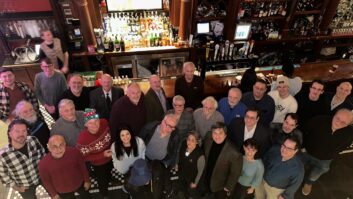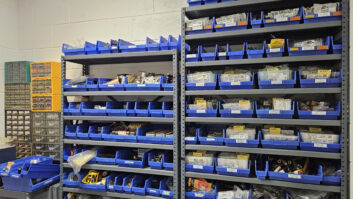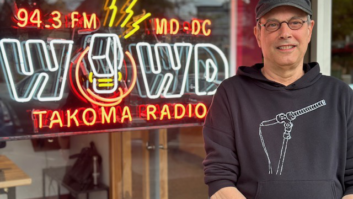
Bill DeFelice is shown in the production studio for HobbyBroadcaster.net. The announced closing of almost half of the FCC field offices has many in the engineering community concerned and worried about the future of the broadcast bands.
Based on my own four decades and more in the industry, it comes as no surprise that many pirate stations had longer life spans due to the lack of FCC manpower to investigate, confirm and prosecute the operators. My own concern comes for those who operate legal, license-free broadcast operations under Part 15 regulations yet have been unfairly targeted by field agents for a variety of reasons.
TARRED WITH ONE BRUSH?
Besides having served as a consultant and staff engineer for a variety of commercial and non-commercial AM and FM stations, I’m the creator and webmaster of HobbyBroadcaster.net, an online reference for radio hobbyists, educational institutions and businesses who want to utilize Part 15-compliant broadcasting. The site was created as a result of building a high school campus-limited station in the district that serves as my 9-to-5 employer.
The feedback I’ve received from my website’s visitors and forum participants is that FCC field agents rarely discern the difference between blatant FM pirates and persons who make a concerted effort to operate within the bounds of Part 15.
For example, it’s all too common that pirates purchase those sub-$100 Chinese-manufactured FM transmitters riddled with spurious emissions on venues such as eBay Inc. In contrast, many Part 15 operators purchase FCC-certified AM transmitters costing hundreds of dollars, with a few models approaching close to $1,000. I sincerely doubt a pirate would buy such an expensive transmitter if their sole intention were to break the law.
One individual was visited by an FCC field agent who had been called on him by a group whose motives were strictly spiteful. He used a factory-fresh i.AM.Radio transmitter that is easy to install and operate; with this transmitter, it would be virtually impossible not to comply with Part 15.219, the applicable regulation for which it was certified.
The operator felt that this agent made some attempt to intimidate his landlord during the visit. The inspector has a reputation for being particularly aggressive, often treating Part 15 enthusiasts with the same disdain as blatant pirate operators.
Part 15 operation on the FM band is pretty much limited to in-home or perhaps “yardcasting,” with the limit on field strength dictated under Part 15.239. This also was explained for the layperson in a 1991 FCC public notice, “Permitted Forms of Low-Power Broadcast Operation.” An unlicensed FM signal that reaches beyond a few hundred feet, at best, is likely out of Part 15 compliance. FM pirates push this tens, hundreds or even thousands of times past the FCC limit.
Some in the engineering community may be under the impression that the range of a legal Part 15 AM signal is limited to 200 feet due to the aforementioned public notice. I personally disproved this while performing an “AM Transmitter Challenge.” This side-by-side operational comparison of five popular Part 15 AM transmitters was performed utilizing a by-the-book, ground-mounted Part 15.219-compliant installation (i.e., 100 mW final stage input power combined with antenna and ground length not exceeding 3 meters). Field intensity measurements were recorded using a Potomac FIM-41 and off-air reception judged using various portable and automobile receivers. In spite of a local ground conductivity of 1 millisiemen per meter, the signal of the best performing transmitter was receivable out to nine-tenths of a mile away using a car radio.
I only know of two individuals in the engineering community who have a vitriolic response when it comes to anyone who willingly participates with Part 15 experimentation on the AM or FM broadcast bands.
Some hobbyists and educational institutions have described their experiences when field agents find non-compliant installations. Some inspectors will simply instruct an operator how to correct the installation for compliance, sparing them from a notice of unlicensed operation. But others may take a harsh no-latitude stance, instructing the operator to shut it all down — or else. This dramatic outcome, appropriate to a pirate, is unfair when applied to a small, well-intended operator who does not intend to violate the rules.
With corporate, group-owned station clusters now engineered by outside contractors, will licensed stations blindly sue Part 15 operators if Commissioner O’Rielly’s plan is implemented? Will dispatched FCC “Tiger Teams” be able (or willing) to differentiate between a Part 15 AM operator who may have unintentionally strayed out of compliance and an obvious pirate FM station, causing harmful interference or sporting a coverage area grossly beyond Part 15 limits?
I contacted both Chairman Tom Wheeler and Commissioner Ajit Pai but have yet to receive any response to my queries. I have also sent a query to Commissioner O’Rielly because my concerns appear topical in light of his blog post, “Consider a New Way to Combat Pirate Stations.”
As a broadcast engineer, I understand the impact of pirate stations, having recently discovered one interfering with the first lower adjacent of a licensed station with which I’m associated.
My hope is that any change in spectrum enforcement doesn’t turn the radio dial into the Wild West, making every Part 15 radio enthusiast or campus-limited signal a potential target for unjustified legal actions simply because it rubs some licensed station the wrong way.
Bill DeFelice is former chief engineer of WMMM(AM)/WCFS(AM) in Westport, Conn., and webmaster of the History of Westport Connecticut Radio. His Part 15 website isHobbyBroadcaster.net.












